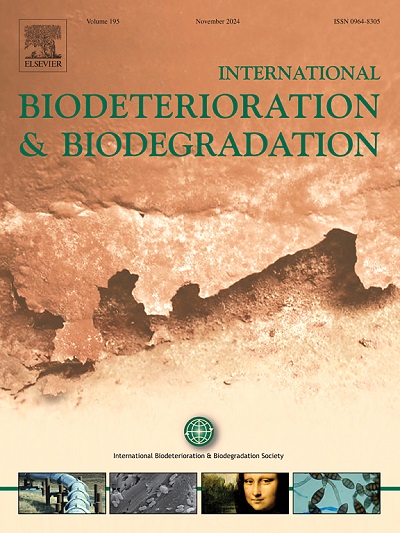The degradation of nicotinic acid is controlled by MarR-family transcriptional regulator NicR in Alcaligenes faecalis
IF 4.1
2区 环境科学与生态学
Q2 BIOTECHNOLOGY & APPLIED MICROBIOLOGY
International Biodeterioration & Biodegradation
Pub Date : 2025-04-22
DOI:10.1016/j.ibiod.2025.106103
引用次数: 0
Abstract
Nicotinic acid (NA), or vitamin B3, is a natural pyridine carboxylic derivative, a precursor for numerous essential biological molecules. Previous studies have demonstrated that microorganisms are essential in NA degradation, exhibiting high genetic and metabolic diversity. This study investigated the biodegradation and regulatory properties of NA by the Alcaligenes faecalis JQ135 and the diversity and interrelationships of microbial metabolism of NA. NicR functions as a repressor in the nic cluster. An electrophoretic mobility shift assay (EMSA) demonstrated that NicR can bind to the promoter regions of R, C, B, A, and P operons in strain JQ135, with these multiple binding sites exhibiting the consensus sequence 5′-GTNNAC-3'. Bioinformatics analysis revealed 24 distinct nic cluster order types. The nic gene cluster in strain JQ135 comprises 15 genes arranged in two distantly located fragments and transcribed as five operons. These configurations are conserved within the genus Alcaligenes and are unique compared to the other 23 order types. The functional correlation among NicRs with differing degrees of similarity was examined, revealing that amino acid residues Q64 and V103 are crucial for NicR regulation. This study offers new molecular insights into the various regulatory mechanisms of bacterial degradation of NA in nature.
粪藻对烟酸的降解受marr家族转录调控因子NicR的控制
烟酸(NA),或称维生素B3,是一种天然的吡啶羧酸衍生物,是许多必需生物分子的前体。先前的研究表明,微生物在NA降解中是必不可少的,表现出高度的遗传和代谢多样性。本研究研究了粪Alcaligenes faecalis JQ135对NA的生物降解和调控特性,以及NA微生物代谢的多样性和相互关系。NicR在nic簇中起抑制作用。电泳迁移率转移实验(EMSA)表明,NicR可以结合菌株JQ135的R、C、B、A和P操纵子的启动子区域,这些多个结合位点显示一致的序列为5 ‘ -GTNNAC-3’。生物信息学分析显示了24种不同的nic簇目类型。菌株JQ135的nic基因簇由15个基因组成,分布在两个相距较远的片段中,转录为5个操纵子。这些结构在Alcaligenes属中是保守的,与其他23个目类型相比是独特的。研究了不同相似度NicR之间的功能相关性,发现氨基酸残基Q64和V103对NicR的调控至关重要。该研究为自然界细菌降解NA的各种调控机制提供了新的分子见解。
本文章由计算机程序翻译,如有差异,请以英文原文为准。
求助全文
约1分钟内获得全文
求助全文
来源期刊
CiteScore
9.60
自引率
10.40%
发文量
107
审稿时长
21 days
期刊介绍:
International Biodeterioration and Biodegradation publishes original research papers and reviews on the biological causes of deterioration or degradation.

 求助内容:
求助内容: 应助结果提醒方式:
应助结果提醒方式:


